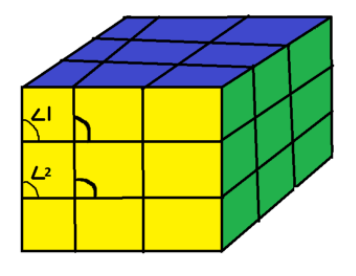
How are corresponding angles used in everyday life?
Answer
444.6k+ views
Hint: Here we need to explain the applications of the corresponding angles. We know that the corresponding angles are defined as the angles which are on the same corner of the transversal line. The transversal line is the line that cuts two or more parallel lines. So we will use this definition and we will give examples in which the concept of corresponding angles is used.
Complete step by step solution:
We know that the corresponding angles are defined as the angles which are on the same corner of the transversal line. Here the transversal line is the line that cuts two or more parallel lines.
The first example in which the concept of corresponding angles is used is the railway tracks.
Let’s draw the figure to understand the use of corresponding angles.

We can see that the track lines are parallel to each other. So using the definition of the corresponding angles, we can say that \[\angle 1\] and \[\angle 2\] are the corresponding angles.
The second example in which the concept of corresponding angles is used is Rubik’s cube.
Let’s draw the figure of Rubik’s cube to understand the use of corresponding angles.

Here we can see that all the lines are parallel to each other in the cube. So the marked angles \[\angle 1\] and \[\angle 2\] are the corresponding angles.
Hence, these are the applications of the corresponding angles in real life.
Note:
Here we need to keep in mind that the corresponding angles made by the parallel lines are always equal to each other. Parallel lines are the lines that do not intersect each other and are at a distance apart from each other. When a transversal line cuts two or more parallel lines, then interior angles are equal to each other. Also, the interior angles on the same side of the transverse line are equal.
Complete step by step solution:
We know that the corresponding angles are defined as the angles which are on the same corner of the transversal line. Here the transversal line is the line that cuts two or more parallel lines.
The first example in which the concept of corresponding angles is used is the railway tracks.
Let’s draw the figure to understand the use of corresponding angles.

We can see that the track lines are parallel to each other. So using the definition of the corresponding angles, we can say that \[\angle 1\] and \[\angle 2\] are the corresponding angles.
The second example in which the concept of corresponding angles is used is Rubik’s cube.
Let’s draw the figure of Rubik’s cube to understand the use of corresponding angles.

Here we can see that all the lines are parallel to each other in the cube. So the marked angles \[\angle 1\] and \[\angle 2\] are the corresponding angles.
Hence, these are the applications of the corresponding angles in real life.
Note:
Here we need to keep in mind that the corresponding angles made by the parallel lines are always equal to each other. Parallel lines are the lines that do not intersect each other and are at a distance apart from each other. When a transversal line cuts two or more parallel lines, then interior angles are equal to each other. Also, the interior angles on the same side of the transverse line are equal.
Recently Updated Pages
Master Class 9 General Knowledge: Engaging Questions & Answers for Success

Master Class 9 English: Engaging Questions & Answers for Success

Master Class 9 Science: Engaging Questions & Answers for Success

Master Class 9 Social Science: Engaging Questions & Answers for Success

Master Class 9 Maths: Engaging Questions & Answers for Success

Class 9 Question and Answer - Your Ultimate Solutions Guide

Trending doubts
Fill the blanks with the suitable prepositions 1 The class 9 english CBSE

How do you graph the function fx 4x class 9 maths CBSE

Difference Between Plant Cell and Animal Cell

What is pollution? How many types of pollution? Define it

Voters list is known as A Ticket B Nomination form class 9 social science CBSE

Which places in India experience sunrise first and class 9 social science CBSE




